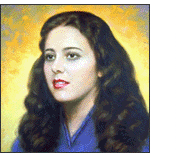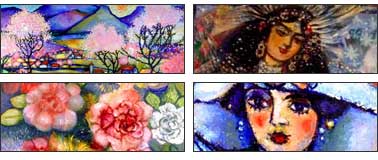
PRESS CLIPS
Almanac Article 1
Almanac Article 2
Times Article 1
Times Article 2
Times Article 3
Burial at Sea Newsletter
Inside Story Almanac
SF Chronical
SM Council Newsletter | 
Famous unknown
How Many times in the history of art has a future "Superstar" become famous and received their fair due only after their demise? Sadly, too many. Rembrandt and Van Gogh are two tragic examples, but there have been so many more. The subject of this presentation is the work of an extraordinary woman named Josephine Robbins. Like her predecessors, her work is on its way to finally receiving the recognition it deserves. The samples in this presentation are just a few of many hundred. However, this sampling of her work speaks for itself and stands on its own. It is simply a taste, a small slice of brilliance.
Josephine Robbins was born October 12, 1918 in the Bronx, New York. Since her mother was a designer and her father was an engineer, it is perhaps no surprise that she began to paint at the ripe old age of three. By the time she had reached the age of twelve, she had submitted and sold her work to various Greenwich Village Art magazines. In 1932, Josephine's father, Saul Samuelson, was invited to the Soviet Union as an engineering advisor, a job that would last for five and a half years.
One might think that Soviet life in the thirties was bleak and bitter and one would be correct. But for Josephine Robbins, an exchange student at the Anglo-American school not subject to the inborn fears and inhibitions which were endemic to communist Russia, it was a period of boundless enthusiasm and personal growth.
With her father, she attended the AMTORG (the famous Moscow art exhibition) and met the great Russian artist, Kravchenko. Primarily a wood cutter, he was nonetheless stunned by the work she had brought for him to see. Kravchenko took Josephine to the Russian Studios of Painting in Moscow. She was accepted immediately (an extreme honor for a foreigner in the Soviet Union and rarity for someone as young as she, 14) and began her studies early in 1933.
Her first and greatest influence was Professor Pankov, a man now considered a legend in Russian art circles. Pankov stressed strict discipline, but also took his students on field trips that provided Josephine with her first exposure to the bleak yet beautiful Russian landscape she would come to paint so well. Within a year, her oil renderings of said landscape were hanging in the Tretikovsky Gallery in Moscow. When she returned to New York in 1937, she was introduced to David Barlund, the editor of the Manhattan Art Review. He was so impressed by the work shown to him that he took it to Dr. David Burluik, the teacher of the great Russian impressionist, Mayakovsky, and a man often referred to as "The Father of Futurism." Dr. Burluik took an instant interest in Josephine's paintings and promptly dubbed his new protege: "The greatest colorist of her time."
Shortly thereafter, (1939) she had moved to San Francisco to meet her soon to be husband, Maxwell Robbins. Within a few short months, in 1940, one of her masterpieces, "Flowers in Flat Blue Vase", (now a treasured part of her daughter, Carla Germano's personal collection) was jury selected to be a part of the San Francisco Art AssociationŐs esteemed 60th Annual Exhibition of Oil Tempera on Panel & Sculpture at the San Francisco Museum of Art. Then again in 1941, two more works were jury selected to show in the 61st Annual Exhibition the following year: "Night time in Old Bryansk", and "Twin Peaks Way."
San Francisco had become her home. In 1942, Josephine gave birth to her first daughter, Dianne. By 1948, she was the proud mother of two more daughters, Carla and Linda. She then devoted her time to motherhood and painting. In the 70's, her kidneys failed. Not even dialysis could keep her from painting. Soon, with the help of her grandson Troy, some of her paintings were accepted into the Oakland Museum archives. During this time she produced what many think of as her greatest work, from her joyfully colorful and magical Russian Landscapes and Winter Scenes to her dark and mysteriously psychological "Clown Series."
In 1983, the year before her death, (one of her most prolific years ever) she
produced her "White Hat Series of Portraits." In 1984, during her final months, being too weak to paint, she began to sketch. She drew thousands of curious pieces, many depicting the story of her life. Some comical, others bitingly satirical, all a social commentary through the eyes of Josephine Robbins. She passed away on Christmas Eve, 1984.
In the opinion of many who have seen and been affected by her work, the words of Dr. Burluik ("the greatest colorest of her time") were undoubtedly correct. She was a woman who had lived her art. The contemporary art community has yet to discover what has already touched the hundreds of people who have seen her unmistakable genius.
by Howard Yudelson
 |





